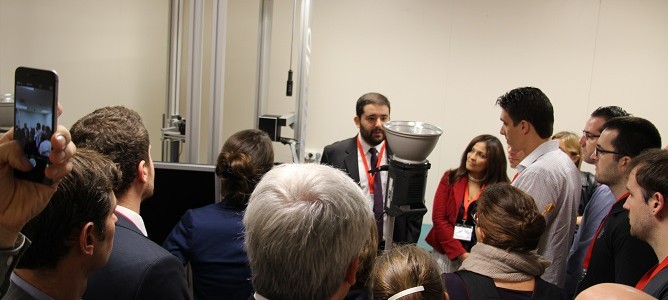
That was one of the conclusions from Dr. Gabriel Buendia at the Barcelona Biophotonics B2B Convention held on 23rd of October at the Hospital Quirón Teknon in Barcelona. The event was organized by SECPhO in close collaboration with the Institute of Photomedicine who, besides being an excellent host, raised a discussion about 4 great challenges for photonics applications in medicine that attracted a big interest from participating SMEs.
The purpose of this event was to bring European companies closer to biophotonics research facilities. This event was one of the 8 workshops to be organized on a quarterly basis in the next two years across Europe by the OASIS consortium (www.fp7-oasis.eu) where SECPhO is one of the project partners.
During the workshop, the activities of the Institute of Photomedicine were presented by Dr. Juan Bascones. Then workshop attendees visited the facilities of the institute where Dr. Gabriel Buendía explained in great detail how and why they use different types of lasers (19 in total) for all kinds of skin treatment. Dr. Buendia was very didactic in explaining why using one or another laser is important depending on the effect you want to produce on the skin and the effects of laser-tissue interaction. The tour lasted more than an hour and 4 laser-operation rooms were visited. All SME participants agreed that it was a luxury to be so close to an end user of laser technology and know firsthand the advantages and disadvantages of use of laser in medical facilities.
Later, a visit to other areas of Hospital Quirón Teknon such as the area of oncology, radiotherapy or medical imaging was made.
After a coffee break, 7 participants from industry had the opportunity to present their capabilities and products for the biomedical sector. These were the following SMEs: PhotonTransfer, 3DBiomedics, Endor Nanotechnologies and In-cognita from Spain, Tematys from France, Optikexpertisen Dr. Volker Raab from Germany and one big enterprise El. En. Group from Italy. Also, 9 photonics clusters from 7 European countries presented capabilities and examples of some of photonic products in this area. These institutions were SECPhO, Photonics NL, Optitec, OptecBB, Polimi Institute, Swansea University, Photonics Sweden, Optoscana and Photonics Bretagne.
Later on, after networking lunch, a discussion about four challenges that were identified by Dr. Buendia took place:
1. Methods for tracing gold nanoparticles
You can see the presentation slides in the following link:
Methods for tracing gold nanoparticles
2. Creating a Real femtosecond laser
You can see the presentation slides in the following link:
Creating a real femtosecond laser
3. Building the everyman’s multiphoton microscope
You can see the presentation slides, in the following link:
Buiding the everyman´s multiphoton microscope
4. Reinventing Sterilisation
You can see the presentation slides in the following link:
Every presentation was followed by an interactive discussion between the industry and hospital representatives analysing the possibilities of making improvements or creating new products for the identified challenges.
A full report with conclusions will be published on the OASIS website (www.fp7-oasis.eu).
Also, in the coming months, new workshops will be organized in other research facilities in various European cities (Rennes in France being the next one!). Interested SMEs should get in contact with their local representative from the OASIS project (www.fp7-oasis.eu/Partners).



